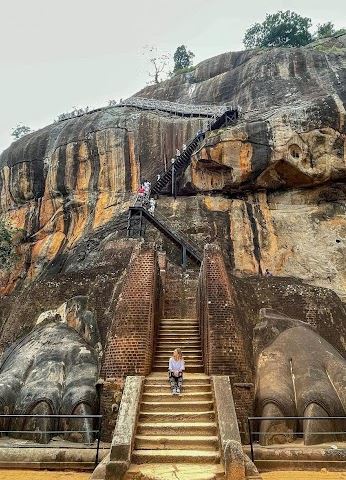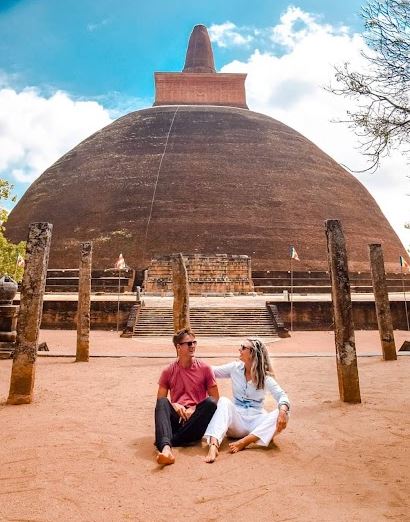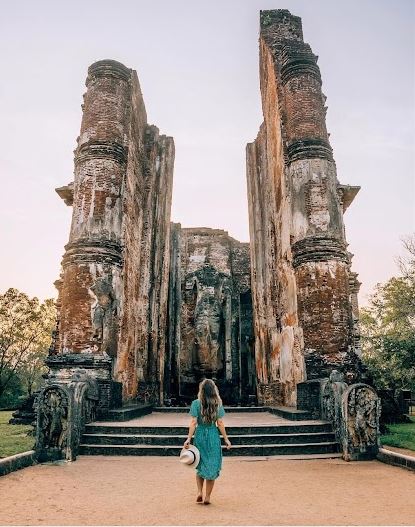Sri Lanka Architecture



Sri Lanka’s architecture is a rich tapestry woven from centuries of cultural, religious, and colonial influences. The island’s architectural heritage spans ancient cities, sacred temples, colonial buildings, and modern structures, each reflecting the diverse history and cultural amalgamation that defines Sri Lanka.
Day Tours to Main Cultural Sites
There are many Cultural Heritage sites to see Sri Lanka Architecture. Most famous places are Anuradhapura, Polonnaruwa, Kandy and Sigiriya.
1. Ancient and Medieval Architecture
Sri Lanka’s ancient and medieval architecture is deeply influenced by Buddhism and Hinduism, with monumental stupas, intricate rock carvings, and well-planned cities being key features.
Sigiriya (Lion Rock)
- Era: 5th century CE
- Overview: Sigiriya, a UNESCO World Heritage Site, is an ancient rock fortress and palace built by King Kasyapa. The complex includes the ruins of a palace, surrounded by an extensive network of fortifications, gardens, ponds, canals, alleys, and fountains. The most striking feature is the Lion’s Gate, where two giant lion paws are carved into the rock, and the frescoes of celestial maidens (Apsaras) that adorn the rock face.
Anuradhapura
- Era: 4th century BCE to 11th century CE
- Overview: Anuradhapura, one of the ancient capitals of Sri Lanka, is renowned for its well-preserved ruins of ancient Sri Lankan civilization. Key architectural highlights include:
- Stupas: Massive dome-shaped structures like the Ruwanwelisaya, Jetavanaramaya, and Abhayagiri Stupa, which were built to house relics of the Buddha.
- Sacred Bodhi Tree (Sri Maha Bodhi): A sapling from the original Bodhi tree under which the Buddha attained enlightenment, surrounded by a sacred enclosure.
- Monasteries and Temples: Ancient monastic complexes such as Mihintale, the site of the introduction of Buddhism to Sri Lanka, and Isurumuniya with its exquisite rock carvings.
Polonnaruwa
- Era: 11th to 13th century CE
- Overview: Polonnaruwa, another UNESCO World Heritage Site, was the medieval capital of Sri Lanka. The architecture here reflects the height of ancient Sinhalese engineering and artistry, with notable structures including:
- Gal Viharaya: A rock temple with four massive Buddha statues carved out of a single granite rock.
- Royal Palace: The impressive ruins of the royal palace of King Parakramabahu I, known as the Vijayanta Pasada, which had seven stories and was surrounded by a large garden.
- Parakrama Samudra: A large artificial lake built by King Parakramabahu I, showcasing advanced hydraulic engineering.
Dambulla Cave Temple
- Era: 1st century BCE onwards
- Overview: The Dambulla Cave Temple, also known as the Golden Temple of Dambulla, is a complex of five caves that contain over 150 statues and murals of the Buddha and various deities. The caves are richly adorned with intricate paintings and sculptures, reflecting the artistic skills of ancient Sri Lankan craftsmen.
2. Religious Architecture
Sri Lanka’s religious architecture is predominantly influenced by Buddhism, Hinduism, Islam, and Christianity, each contributing to the island’s rich architectural diversity.
Buddhist Temples
- Temple of the Tooth (Sri Dalada Maligawa): Located in Kandy, this temple is one of the most sacred Buddhist sites in Sri Lanka as it houses the relic of the tooth of the Buddha. The temple complex features traditional Kandyan architecture with a golden roof, intricate woodwork, and beautiful paintings.
- Kelaniya Raja Maha Vihara: A Buddhist temple near Colombo, believed to be visited by the Buddha during his third visit to Sri Lanka. The temple is renowned for its elaborate murals depicting scenes from the life of the Buddha and the history of Buddhism in Sri Lanka.
Hindu Temples
- Nallur Kandaswamy Kovil: Located in Jaffna, this is one of the most significant Hindu temples in Sri Lanka, dedicated to Lord Murugan. The temple is known for its towering gopuram (gateway) and vibrant annual festival.
- Koneswaram Temple: Perched on a cliff in Trincomalee, this ancient Hindu temple is dedicated to Lord Shiva. It is known for its Dravidian architecture, with intricate carvings and stunning views of the Indian Ocean.
Islamic Architecture
- Jami Ul-Alfar Mosque: Also known as the Red Mosque, located in Pettah, Colombo. This iconic mosque, with its striking red and white candy-striped façade, is a prime example of Indo-Saracenic architecture in Sri Lanka.
- Ketchimalai Mosque: Situated in Beruwala, this is one of the oldest mosques in Sri Lanka. The mosque’s architecture blends traditional Islamic features with local design elements, offering stunning views of the coastline.
Christian Churches
- St. Lucia’s Cathedral: Located in Colombo, this is one of the largest and oldest Roman Catholic churches in Sri Lanka. The cathedral’s architecture is inspired by Renaissance and Baroque styles, with an impressive façade and a towering dome.
- Dutch Reformed Church: Situated in Galle Fort, this church was built during the Dutch colonial period in the 18th century. It features Dutch colonial architecture with a gabled roof, wooden pews, and an intricate pulpit.
3. Colonial Architecture
Sri Lanka’s colonial period left a lasting impact on its architecture, with Portuguese, Dutch, and British influences evident in many buildings.
Dutch Period
- Galle Fort: A UNESCO World Heritage Site, Galle Fort is a fortified city built by the Portuguese in the 16th century and extensively fortified by the Dutch in the 17th century. The fort’s architecture includes Dutch-style buildings, churches, and warehouses, all surrounded by thick ramparts and bastions.
- Old Dutch Hospital: Located in Colombo Fort, this building dates back to the Dutch colonial period and is one of the oldest structures in the city. It has been restored and now houses upscale shops and restaurants, retaining its original colonial charm.
British Period
- Queen’s Hotel: Located in Kandy, this hotel was originally a Governor’s residence during the British colonial period. The architecture reflects a mix of British and local styles, with grand verandas, high ceilings, and elegant colonial décor.
- Old Parliament Building: Situated in Colombo, this neoclassical building served as the Parliament of Ceylon during British rule and now houses the Presidential Secretariat. The building features grand columns, symmetrical design, and a stately appearance.
- Nuwara Eliya: Often referred to as “Little England,” this hill town is dotted with colonial-era bungalows, Tudor-style hotels, and manicured gardens, reflecting the British influence on the island’s architecture.
4. Modern and Contemporary Architecture
In recent years, Sri Lanka has seen a surge in modern architectural developments, blending contemporary design with traditional elements.
Geoffrey Bawa’s Influence
- Geoffrey Bawa is regarded as the father of modern Sri Lankan architecture. He pioneered the Tropical Modernism movement, which integrates buildings with their natural surroundings.
- Kandalama Hotel: Designed by Bawa, this hotel in Dambulla is a prime example of his work, seamlessly blending into the surrounding landscape with minimal environmental impact.
- Parliament Complex in Sri Jayawardenepura Kotte: Another of Bawa’s masterpieces, this building combines modern architectural elements with traditional Sri Lankan aesthetics, set on an artificial island surrounded by water.
Contemporary Developments
- Lotus Tower: Standing as the tallest structure in South Asia, the Lotus Tower in Colombo is a symbol of modern Sri Lankan architecture, with its distinctive lotus flower-inspired design and state-of-the-art facilities.
- Altair: A striking twin-tower residential development in Colombo, designed by Indian architect Moshe Safdie, featuring a unique leaning structure that has redefined the city’s skyline.
Day Tour Price to Cultural Sites
- Transport Cost for Anuradhapura USD 95 – Polonnaruwa USD 95 – Sigiriya USD 70 per private tour in an A/C car or van with an English speaking chauffeur-guide
Vehicle Options:
Car (up to 2 persons): Toyota Axio, Prius Hybrid, Premio/Honda Fit Shuttle or similar
Van (3 to 6 persons): Toyota KDH/Nissan Caravan or similar
- Entrance ticket fee for Anuradhapura/Polonnaruwa/Sigiriya Sri Lanka – Ticket price for each place US$ 35 / EUR 31 / GBP 26) per foreign adult and US$ 17 / EUR 16 / GBP 13 ticket price per foreign child of age 05 – 12 years are applicable.
